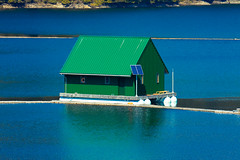 Image by eyesplash Mikul via Flickr
Image by eyesplash Mikul via Flickr
Could a Snake Be the Answer to Renewable Energy? by Matthew Loop
As the race to develop a viable solution to the world's renewable energy dilemma continues apace, the answer could lie beneath the waves. A recent announcement by a team of British scientists suggests affordable wave energy could be just years away.
On first impressions, the technology seems little more than an extended rubber tire tube. However, once in the water, it is easy to see why it has been dubbed "The Anaconda" throughout its development and into the first stage of testing.
Much as the sea snake from which the kit takes its name, this rubber beast lurks just below the waters surface, lying in wait. However, quite apart from waiting for something tasty to swim by, this Anaconda waits for a wave to pass over it. Through a relatively simple process that will be explained later, a turbine is driven. Potentially, this could create enough energy to power as many as one thousand homes when scaled to full size.
As waves start to move over Anaconda, a bulge of air placed in the rubber tubing is excited by the motion. This causes an up and down movement, which in turn takes power from the surrounding water. Creating a wave within the tube itself, the bulge is driven across the turbine, producing energy. The further the bulge travels through the tube, the more power is produced and returned. And thus the process cycles.
To the layman, this sounds extremely scientific. However, those in the field of study agree it is a relatively easy concept to grasp. And more importantly, the ease in which it could be reproduced, scaled up and manufactured across the world, is what makes this such an exciting platform to consider.
That it promises to be quickly and effectively produced, is not the only huge advantage of the technology. Previous attempts at harnessing wave energy have failed, or had limited success, due to mechanical failure or erosion of key components. With the Anaconda, this is unlikely to happen. With a completely non-mechanical construction, there is little to break, or be damaged by the forces of the ocean.
Its rubber construction makes it less susceptible to be affected by the motion of the waves, or the naturally salty conditions. Also easy to maintain in-situ, post-production costs will be kept to a minimum - another major downside to existing platforms.
The prototype launched to the public in early May 2009, is some way short of the full ocean-going version that needs to be tested before the technology can be completely signed off. However, with the developing team looking for a relatively small sum of little over ten million US dollars, they are confident the testing phase will begin shortly.
Whilst a lot of time and money has gone into developing new technologies for solar and wind renewable energy, wave energy is climbing the ranks fast. With waves a constant force across the world's oceans, reliable power could be generated with minimal or no disruption to the grid within the next five years.
Want to inexpensively create your own renewable energy? Save hundreds per year with the DIY solar/windmill power kit at http://TheEarth4Energy.com.
Article Source: http://EzineArticles.com/?expert=Matthew_Loop
http://EzineArticles.com/?Could-a-Snake-Be-the-Answer-to-Renewable-Energy?&id=2333306
http://thezeitgeistischanging.blogspot.com/
http://psychedelichippiefashion.blogspot.com/
http://psychedelichippiemusic.blogspot.com/
http://www.soul-flower.com/Merchant2/merchant.mvc?Screen=SFNT&Store_Code=SOS&AFFIL=Robert_Muller
No comments:
Post a Comment